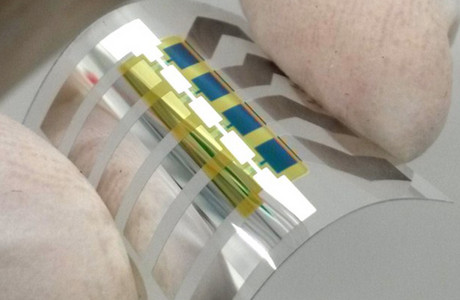Biodegradable thin-film sensors for monitoring wood-based parts and components
30. January 2024

In order to counter safety concerns about timber structures and thus increase their acceptance, the structural integrity of potentially endangered construction areas must be permanently monitored using in-situ measurement methods and sensors that are as invisible as possible and can be permanently installed.
In order to increase the ecological and economic added value of using wood in construction, these sensors themselves should have a high sustainability potential and should not impede the recycling of the wood in the sense of circularity.
The aim of a research project carried out jointly by the IAPP, the HTW and the IHD is to develop a biodegradable thin-film sensor system for the simultaneous detection of expansion, moisture and temperature for use in timber construction. The sensor system intended for permanent monitoring should reduce safety concerns about the material, increase the acceptance and spread of timber construction and not hinder the circular reuse of wood. A 3-dimensional layer structure of the sensor material should make it possible to record expansion, moisture and temperature changes in such a way that cross-dependencies of the three variables are eliminated by means of suitable algorithms and the associated misinterpretations are prevented. By creating the possibility of substituting conventional electronic components with organic-electronic counterparts, the project lays the foundations for the development of sustainable electronic sensor technologies with a better carbon footprint than conventional technologies on the market. In addition, all materials required for the production of the sensors can be procured in Europe, thus avoiding critical countries of origin and raw materials (e.g. rare earths). With timber construction companies, engineering and planning offices, measurement technicians and manufacturers of organic electronics, the potential user group for the results is largely made up of SMEs. In terms of perspective, the use in timber construction pursued in the project should only be seen as a first step, as there is also a considerable need for functional monitoring of construction elements made of other materials and their joining zones. In particular, the combination of biodegradability, thin-film technology and future cost-effective production in a roll-to-roll process opens up a wide range of fields of application, especially in vehicle and mechanical engineering, in (food) packaging technology or for medical and biotechnological applications.
The project with the funding code 23086BR is funded by the Federal Ministry for Economic Affairs and Climate Protection as part of the Industrial Collective Research (IGF) funding guideline.
Contact person for the project at the IHD is:
Jens Wiedemann
jens.wiedemann@ihd-dresden.de
